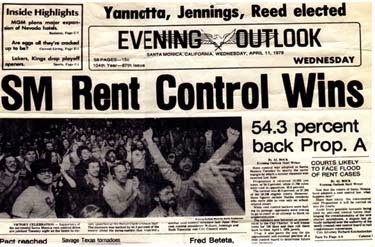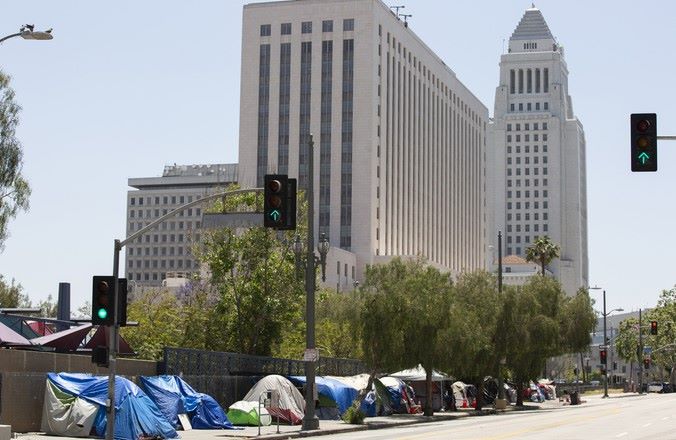By Michael Tarbet and Denny Zane, SMRR Co-Founders
In honor of the passing of Roger Thornton, a SMRR Co-Founder and friend
Chapter One
The Santa Monica of the 1970s was a good place for a low or moderate-income renter household to find a home. As a result, it was an economically diverse community with over 70% of all residents being renters, many retired living on fixed incomes. Nearly half of Santa Monica renters were in low-income households.
But real estate speculation throughout Southern California was starting to drive rents up in Santa Monica, Los Angeles, and other communities, forcing an increasing number of renters to give up their homes. Conversions of apartment buildings to condominiums, with entire buildings experiencing evictions made this process all the more painful, stark, and visible. The tax structure of the time encouraged investment groups to buy buildings and increase rents while the new owners waited for the value to increase for a sale. That in turn encouraged other landlords to increase rents.
Tima Tomash was a Santa Monica tenant at that moment, caught up in the uncertainty and anxiety of rapidly rising rents and condo conversions. But Tima had spirit. She had been an activist school teacher and union member who had been blacklisted during the McCarthy Era. She had even been called before the U.S. Senate Subcommittee to Investigate the Administration of the Internal Security Act in 1953 and had spent time with artists Diego Rivera and Frida Kahlo in Mexico and with ex-patriots who had left the US due to the oppression of the era. Her husband was murdered in Mississippi during the Civil Rights Movement. Tima was about to become an important voice for the senior community in Santa Monica.
Activist seniors petition the City of Santa Monica for rent control
In 1977, Tima and other older activists, mostly women in their 70’s and 80’s, began complaining to the City of Santa Monica Housing Commission about rising rents, catching the attention of commissioner Syd Rose. Rose, a labor attorney and union activist, was moved by their testimony. He initiated discussions with Legal Aid attorney Robert M. Myers who then drafted a Rent Control Charter Amendment, a vital step for rent control in Santa Monica.
But it was Tima and a team of dynamic older adults – Ida Singer, Rose Boin, Lillian and Al Storik, and Sylvia Hill – who were the true backbone of the Santa Monica Committee for Fair Rents. They made it their mission to organize the signature drive and collect the thousands of signatures needed to place the first rent control measure on the June 1978 Santa Monica ballot. They succeeded with their heroic effort.
Ironically, it turned out to be the same election when Howard Jarvis’ Proposition 13 was on the statewide ballot.
Rent control activists seek help from CED
After the 1978 rent control measure had qualified for the ballot in Santa Monica, these same elderly rent control champions reached out and approached the Santa Monica-Venice Chapter of the Campaign for Economic Democracy (CED) looking for help.
CED was founded by Tom Hayden and Jane Fonda after Tom’s inspiring, but ultimately unsuccessful, campaign to unseat U.S. Senator John Tunney in 1976. While Tom’s campaign and many CED activists had their political roots in the anti-Viet Nam War and the environmental movement, local CED chapter members were very interested in the local rent control movement. Two CED members, Denny Zane and Parke Skelton, were especially eager and agreed to check out the effort. They came back to the chapter enthusiastic about the campaign.
However, statewide CED and Tom at that very moment were on the verge of launching a statewide solar energy campaign with Governor Jerry Brown. The local CED chapter did not have the capacity for both efforts. But Zane and Skelton had become too deeply involved in the Santa Monica rent control effort to leave their new friends, the older rent control activists, in the lurch.
A number of the members of the Committee for Fair Rents were dissatisfied with Syd Rose’s approach to the upcoming election. Syd thought they had done sufficient work to qualify the rent control measure and should just let the voters vote. Those who wanted to build a more significant campaign asked Denny and Parke, by then experienced campaigners, to co-manage the campaign. The two agreed.
The Santa Monica Fair Housing Alliance forms
The first step was to organize an alternative group to the Committee for Fair Rents, a group that could bring together a broader base of involvement. That effort, which came to be called the Santa Monica Fair Housing Alliance (SMFHA), joined the efforts of younger activists with those of the activist seniors into one campaign and, in effect, relaunched the rent control campaign.
SMFHA found a rich reservoir of activists in the Santa Monica community, activists that had challenged developments before the Coastal Commission, had worked to save the Santa Monica Pier, had attempted to stop the development of the Ocean Park Redevelopment Project and Santa Monica Place (winning numerous concessions), had created Fair Housing For Children to challenge landlord’s restrictions on families in rental housing, and had founded the first community organization and community newspaper in Ocean Park.
It was a coalition of activists from the New Deal era together with anti-war and social justice activists from the ‘60s and 70s, joining together for renters’ rights in Santa Monica.
A founding SMFHA leader, Cheryl Rhoden, a Santa Monica renter with a young son in whose apartment the new organization was created, became the new voice of the campaign. (Cheryl would become a Santa Monica City Council member.) Cheryl’s apartment became a hub for weekly meetings with activists cramming in, sitting on the floor, and sharing more than one bottle of wine and a good many laughs as they planned the upcoming week’s actions.
Michael Tarbet, an attorney by training, but an activist at heart, became a key SMFHA leader and a coordinator of the field operation, a role he would later assume within SMRR for many years (Mike later also started the SMRR Hotline program in 1992 to assist tenants with challenges with their landlords – a program that he continues to supervise even today: call 310-394-0848).
In spite of differences about strategy, Syd Rose, ever a gracious man, invited the SMFHA crew to use his garage as an “office” as the election campaign moment arrived. Tarbet was joined in Syd’s garage by Moe Stavnezer, Lynda Vitale, Dora Ashford, Susan Morrow, and the dynamic squad of senior activists who really had started it all. They mobilized people to distribute flyers throughout the city. It was easy then to get volunteers because everyone was losing neighbors to rising rents and condominium conversions and often felt threatened themselves.
Santa Monica’s first rent control measure fails
Despite those heroic efforts, that first rent control measure in June, 1978 failed, 46 percent to 54 percent. The landlord coalition outspent the rent control advocates $250,000 to $10,000. Both tenant and homeowner voters were a bit fooled because apartment owners said they’d lower rents if Proposition 13 passed and reduced their property taxes. In addition, homeowners then tended to side with landlords on these issues – in part because they sympathized with mom-and-pop owners of small apartment buildings who would have been subject to rent control.
Meanwhile, though Proposition 13 won handily statewide the rents in Santa Monica and cities throughout California still rose. Renters throughout the state felt burned, and THEY mobilized to press for rent control. City Councils in Los Angeles and San Francisco adopted local rent control ordinances giving the movement momentum and legitimacy.
In the aftermath of the June, 1978 defeat, the debate locally among activists in Santa Monica became: Should we try the rent control measure again or try to organize tenant unions in individual buildings? Rents continued to rise, renters would resent the broken promises of Howard Jarvis, and we would be better organized than in the last effort.
The Beginnings of Santa Monicans for Renters’ Rights (SMRR)
Denny Zane and Parke Skelton approached Rev. Jim Conn to host a meeting of Santa Monica activists in his home. Jim’s Church in Ocean Park had become a Santa Monica spiritual and activist center committed to social and racial justice. At that meeting, Denny and Parke would try to convince other activists that another rent control ballot measure was the smart course. The first measure had done much better than expected and, with lessons learned, they could run a better campaign, including placing a greater focus on fundraising to support a direct mail program. And, an improved measure, with exemptions for small owner-occupied buildings, could do better. But most of all, the measure would expand its base as rents continued to rise, despite pledges of reasonable rent from a few landlords.
A second meeting at Linda Garrett’s Bookshop in Ocean Park off Main Street sealed the course, as those gathered agreed to push for a second try at a rent control measure.
It was in the aftermath of the losing rent control measure and these meetings that Santa Monicans for Renters’ Rights was born. SMRR was initially a coalition of SMFHA, the Committee for Fair Rents, the Santa Monica Democratic Club, and, this time, the Santa Monica Chapter of CED. CED had joined and had become a foundational piece of the coalition. Later, this coalition would be joined by the Pico neighborhood-based Santa Monica Tenants Union and the Ocean Park Electoral Network (OPEN).
New rent control effort gears up – with sights on the City Council as well
Denny Zane and Michael Tarbet went to talk with Bob Myers to make strategic revisions in the rent control measure. In particular, they proposed that apartment buildings with only two or three units with one unit owner-occupied should be exempt from the rent control measure, making it harder for the opposition to claim that mom-and-pop landlords would be hurt by it.
Once the signature drive started, the campaign easily recruited volunteers and signatures, and a new rent control measure was placed on the ballot for the April 10, 1979 election.
In addition to advocating for the rent control measure, the SMRR coalition decided to support two candidates for the Santa Monica City Council: Ruth Yannatta Goldway, a former assistant to the director of California’s Department of Consumer Affairs and a former candidate for the California State Assembly; and Bill Jennings, an attorney, who had recently been the President of the Santa Monica Democratic Club.
Ruth’s husband, Derek Shearer, who had worked in national progressive political circles and had run Ruth’s nearly successful campaign for the California State Assembly in 1978, became a close and regular advisor to Parke and Denny on campaign strategy.
The SMRR coalition was convinced by Democratic Club leader Ken Edwards not to run a candidate for the third city council seat that was up that year. Ken didn’t want us to challenge one incumbent, Christine Reed, a moderate Republican with good environmental credentials and important roles at the Southern California Association of Governments (SCAG). We accepted Ken’s advice.
SMRR coalition and CED contribution pays off
This time, rent control advocates were much better organized. We had the amazing energy and tenacity of the senior women and men who had started the effort, the community reach and savvy of longtime community organizers, and the campaign skills that CED brought to the effort. Cheryl Rhoden, the emerging voice of the movement, had both the leadership skills and the capacity for empathy that the Santa Monica community would trust.
Parke and Denny would lead the campaign organizing. Denny became the interface with coalition partners, organizing coalition meetings, meeting with and speaking to tenants in their buildings around Santa Monica. Parke took on the task of designing a direct mail program, presaging an exceptional future career as one of California’s most successful political consultants. He would work off-hours with staff at Don Girard’s Guttenberg 2000, a print design and layout shop, to put it all together.
With help from computer programmer Michael Adams, Roger Thornton of the CED Chapter took on the task of learning the skills of the newly emerging discipline of computer data management, allowing our direct mail program to become the near-equal of some of the most sophisticated targeted direct mail practitioners of the time.
CEDers Ralph Brave and Pam Baker played key roles. Ralph coordinated press and media outreach, with Cheryl and Pam organizing the final week Get-Out-the-Vote operation, sequestered on the second-floor mezzanine of the Church in Ocean Park.
Importantly, the Retail Clerk’s Union Local 1492 and their President Michael Straeter became supporters of the campaign and opened up their union hall for meeting and events – and encouraged one of their staff, Dolores Press, to become active with the campaign. Dolores injected a progressive feminism into all SMRR discussions.
This time we worked to raise a lot more money, more than $50K (if we remember correctly). Most of the funding was raised primarily through what we called “the Boogie Strategy”– a series of well-attended dance parties at the Church in Ocean Park with a veritable history of rock ’n roll on cassette tapes Denny had put together. When the dances became too crowded, Michael would hide the collected money in books in Rev. Conn’s library. Some of us think there could still be money to be found. Cheryl was rumored to have received a ticket one night for having a “dance without a permit.”
Dancing while working for renter justice was a potent energizer. While we raised much more money, no one received compensation for their efforts, as we were all volunteers. But, it wasn’t all dancing and walking precincts. Landlord groups were mobilizing and still outspending the emerging tenants’ movement – amidst an atmosphere increasingly of tension and even threatened violence.
On one memorable occasion, Ida Singer (then in her 80’s) was staffing the SMRR office in the Mendota Block Building on Hill St. near the Church in Ocean Park when she urgently called Cheryl Rhoden and said “They’re tearing the building down around my ears and I’m not budging.” Cheryl put out the call and activists converged on the office to find some of the walls in the building torn apart and toilets in the hallway. Parke and Denny worked with Bob Myers to seek an emergency stop work order. The building’s owners had not sought the necessary approvals for the work and had not notified tenants.
But it was part of the new normal. Scores of apartment owners were demolishing apartment buildings around the city to remove them from the market before the rent control initiative might pass. Even former Santa Monica Mayor Donna Swink joined the “demolition derby.” Her elderly aunt was filmed being carried out of one of the former mayor’s apartment buildings only minutes before the demolition began.
As the final weekend before the election came, activists were entranced with the “magicality” of the common effort. CED brought in about 200 volunteers from CED chapters around the state for a weekend precinct walk, organized out of the Retail Clerk’s Hall, and Tom and Jane addressed GOTV rallies to encourage the effort.
Santa Monica voters approve rent control – and elect the first two SMRR council candidates
On April 10, 1979, not only did the voters of Santa Monica pass the rent control measure, 54 percent to 46 percent, but they also elected both SMRR candidates to the Santa Monica City Council. Christine Reed was re-elected but ran a very distant third. Likely, SMRR could have easily elected a third candidate had we run one.
This election night was an important night in the history of Santa Monica, a night of incredible celebration and jubilation. Against all odds, a coalition of activists whose ages spanned five decades of working for social justice had won. It took thousands of hours of meetings, walking precincts, showing up at City Council meetings to voice dissent, and building a grassroots movement of mostly low and moderate-income tenants.
And a local renters’ rights movement had been born; an organization, Santa Monicans for Renters’ Rights, had been created to give successful political voice to that movement of tenants for the first time in the history of the City of Santa Monica. The most comprehensive rent control law in the nation had become the law of our beach city, and the movement had placed two of its leaders on the City Council (though Jennings would soon break with SMRR over what he called the “radical agenda” of the coalition).
That April election was quickly followed by the election of Rent Control Board members in June. SMRR candidates swept all five seats, electing Bill Allen, Gerry Goldberg, Dolores Press, Neal Stone, and Renee Gould. The scare-mongering anti-rent control campaign had worked in part – small landlords were terrified they would lose their property, threats were made against some activists, one renters’ rights activist was even punched at a Rent Board meeting and landlords booed through the Pledge of Allegiance and the Invocation. At one meeting a landlord became so overwrought that Ken Edwards, a probation officer, pulled out his peace officer badge to calm her. The bear on his badge fell to the floor – it was the only funny moment that night.
In November of that year, 1979, Cheryl Rhoden was elected to an unexpected vacancy on the Santa Monica City Council, occasioned by the resignation of former Mayor Donna Swink, who had been diagnosed with cancer. A landlord-sponsored measure to water down the rent control law was defeated. Santa Monicans for Renters’ Rights evolved from a coalition of organizations to the membership organization it still is today.
Soon the movement would command a majority on the Santa Monica City Council, as well as the Rent Control Board, and a short time later, the Santa Monica-Malibu Unified School Board and the Santa Monica College Board of Trustees. Ruth Goldway would become SMRR’s first elected Santa Monica Mayor.
Every single person who gathered signatures for the rent control measure, showed up at a city council meeting, or walked a precinct or passed out flyers at supermarkets were SMRR founders. Each was an important part of building a local movement that has today lasted over forty years of twists and turns.
Santa Monicans for Renters’ Rights would hold majorities on each of these local elected bodies for most of the next forty years. What has it meant for the city? Quite a lot actually.
The photo is from April 10, 1979. A Victory Party at Dolores Press’ Retail Clerks’ Union Hall. Whoopee!
Check back in on Wednesday, May 25 for another piece from Mr. Zane on Transportation in L.A. County
Stay informed. Sign up for The Westside Voice Newsletter
By clicking submit, you agree to share your email address with Westside Voice. We do not sell or share your information with anyone.








